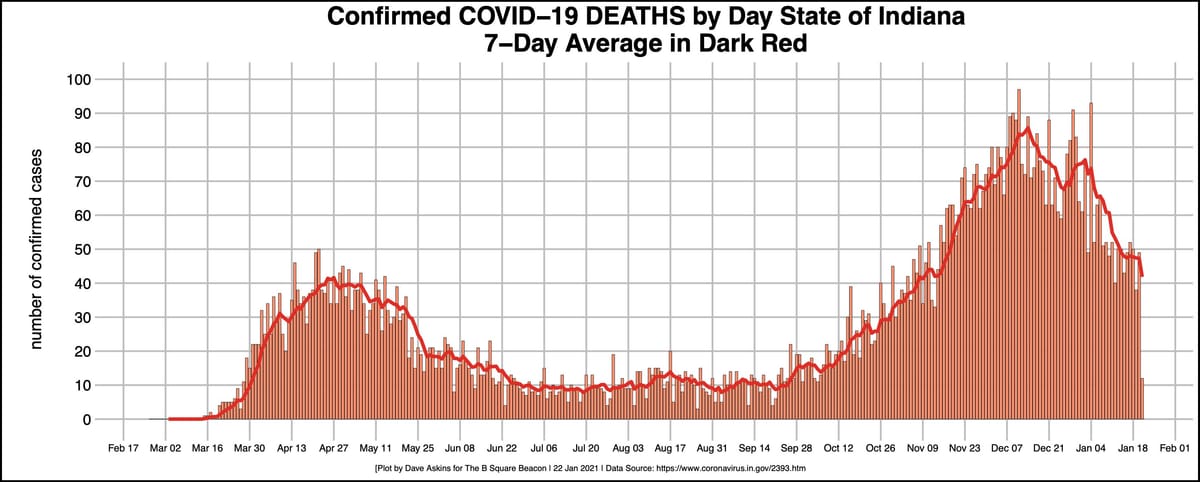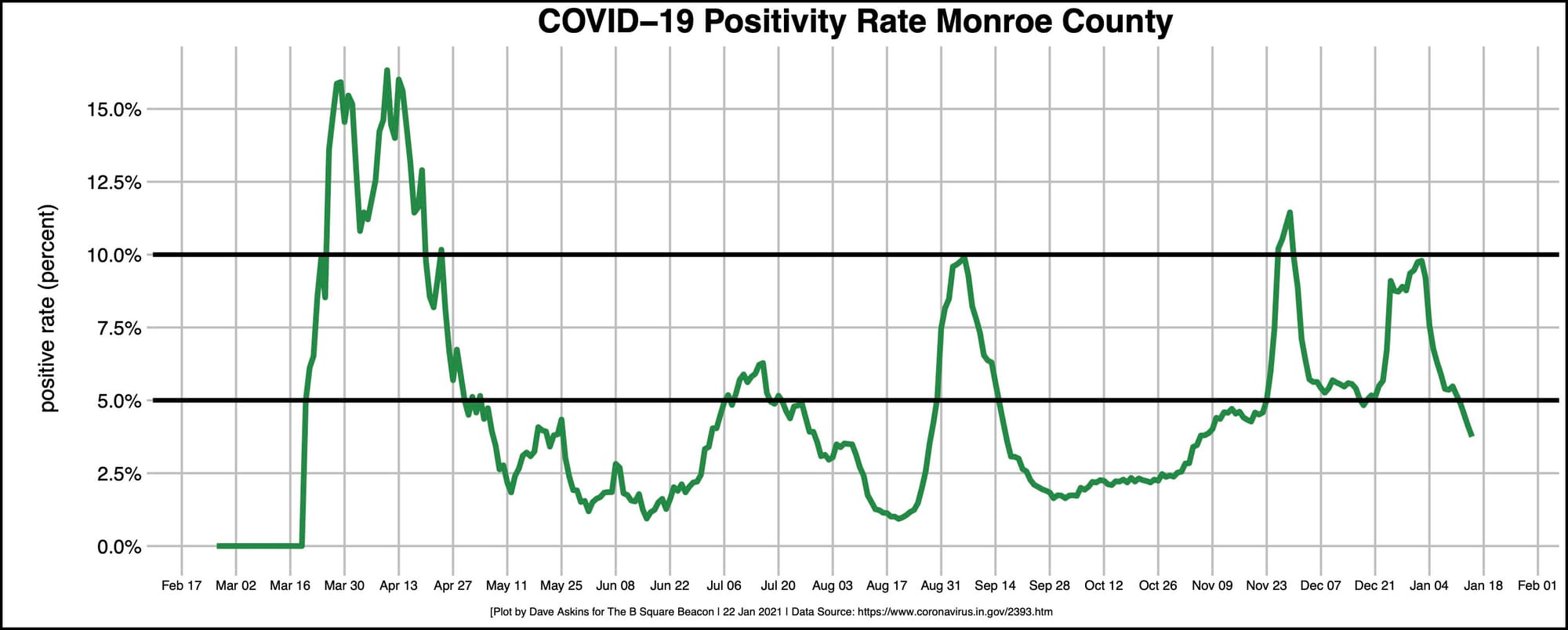COVID-19 update: Availability of vaccine still key barrier to shots in arms; declining case numbers boost morale






The main barrier to COVID-19 vaccine distribution in Monroe County, as well as other parts of the state and country, continues to be the availability of the vaccine.
As many 1,000 additional doses of vaccine a day could be distributed by Indiana University, according to IU’s assistant vice president for strategic partnerships Kirk White. He was speaking at Friday’s weekly news conference of local leaders on COVID-19 response.
Whenever the state is able to allocate vaccine to the university as a distribution site, White said, “I’m pretty comfortable that we could do between 500 and 1000 vaccinations that day, if we had the supply.”
For now, the only vaccination clinics in the county are being operated by IU Health and Monroe County’s health department. The vaccine is free, but appointments are required for both clinics. For now it’s only frontline healthcare workers and those over 70 years old who are eligible.
Countering general frustration about vaccine availability on Friday was a sustained downward trend for confirmed positive cases, hospitalizations, and deaths, in Monroe County and across the state.
Monroe County area health officials said on Friday they’re trying to maximize the amount of COVID-19 vaccine that gets distributed by the state to area clinics.
The strategy is straightforward: Put as many shots in arms as possible, to use up the vaccine that’s been allocated.
At Friday’s weekly press conference of local officials, Brian Shockney, who’s president of IU Health’s south central region, connected that strategy to the state’s vaccine allocation policy: “If you’re not using very much vaccine, you get less supplies coming to you. If you’re utilizing more and more, you get more supplies sent to you the next week.”
Shockney pegged the local totals at 12,081 doses of vaccine out of 13,175 that have been allocated by the state, or 91.7 percent. The remaining 8.3 percent is still pending distribution.
That doesn’t mean that all of the county’s roughly 10,000 frontline healthcare workers have received their first dose, Shockney said. The database used to track vaccine administration doesn’t distinguish between those who have been given a shot because they’re healthcare workers, and those who have qualified based on being older than 70.
IU Health has been distributing 600 to 700 vaccine shots a day. One day next week is scheduled for 900 vaccinations, Shockney said. That’s possible because IU Health continues to get the weekly shipments it needs, to cover the next week’s appointments.
Both the vaccines, from Moderna and Pfizer, require cold storage and can go bad if they’re thawed but not used. The figure of 91.7 percent use, which was cited by Shockney, doesn’t mean the remaining 8.3 percent of the vaccine has been thrown away.
According to Shockney and Monroe County health administrator Penny Caudill, no vaccine has been going to waste in Monroe County.
Shockney described how the vaccine gets thawed and syringes are filled on an as-needed basis. “The requirements are such that our pharmacists thaw and mix it throughout the day, about every two hours. So for that 12 hours, we’re open, they’re continuously mixing and filling syringes,” Shockney said.
Does vaccine get wasted if appointments are cancelled?
Shockney said not a lot of appointments get cancelled. But during the day, if an appointment is cancelled, a thawed shot just goes into the arm of the next person in line who has an appointment. That means one less shot that needs to be thawed later in the day. At the end of the day, if there are one or two thawed vaccine doses left over, they’re given to healthcare workers at IU Health’s hospital, across the street from the vaccine clinic.
On the topic of end-of-day leftovers, Caudill said that the county has set up a weekly “standby list” where people can sign up, in case there is ever a thawed “extra” dose of vaccine ready to be delivered, but no available arm to jab with a needle. Caudill said it’s not expected there will be very many doses left at the end of the day.
Caudill said the state health department has an ethics committee that is working on the next phases of distribution. “Certainly bus drivers, teachers—there are lots of critical infrastructure groups that would have good reason to need to be vaccinated, there is no doubt about that,” Caudill said.
But for now, eligibility is age-based, because age is the main factor for deaths and hospitalizations, Caudill said.
Meanwhile all the COVID-19 disease data is trending downward.
In Monroe County the rolling average of confirmed cases is now around 50, after hitting a relative high of 80 in the second week of January.
Across the state of Indiana, the rolling average of cases is down to around 3,200 after hitting a relative high around 5,400 in the first week of December.
Monroe County’s rolling average positivity rate (all tests) is now down to 3.8 percent, after hitting a relative recent high of around 10 percent. The statewide positivity rate is now down to 10 percent, after starting the year around 16 percent.
The rolling average of daily deaths across the state is around 40, which is about the same as the spring 2020 peak, even if it’s lower than the more recent relative high of more than 80 in early December.
At Friday’s press conference, Indiana University’s Kirk White noted a somber milestone for nationwide death numbers: “One milestone we hit sometime last night was the 407,000 deaths in our country of COVID, which means that last night we just passed the total number of service members killed in World War II over four years. That shows the breadth and depth of this emergency.”




Comments ()